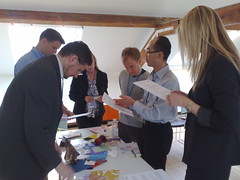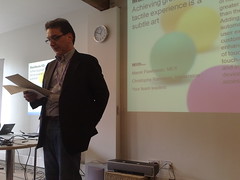MEX: Breakout groups on materials
MEX: Breakout group on materials
 We broke out into groups. Ours was looking at materials: identifying a couple (from a large collection) that could be used to create a future mobile product.
We broke out into groups. Ours was looking at materials: identifying a couple (from a large collection) that could be used to create a future mobile product.
We looked at Bamboo fibres, thermosensitive
Steph's group: lists buttons that couldn't go into touch-screen without impairing UI. Usefulness of volume control as a physical affordance doesn't mean you shouldn't have touchscreen version - combine and have both.
Disadvantages: can be confusing, relying on software can mean you have to use two fingers.
Big advantage of hardware is the reassurance of having done something physical.
Next group, 2dogleg, asked: can you develop a standard palette of haptics for all handsets?
"We skirted the issue a little bit" :) Ended up with use-cases where haptics would feel welcome: silent alerts, tracking location within the keyboard (for sightless text entry), button confirmations, linking to animations (so that you get a feeling from the phone when moving screen-to-screen), showing affordances.
Next group, 2corner, discussed new physical materials to be used in mobile devices: why aren't we using new ones?
 Jo Rabin takes the floor. Talking about wand properties - phone responds in colour, shape and texture to altitude, pollen or swine flu. Samsung has antibacterial keyboard coatings. Squidgy phone might be useful as a grip, to fit the exact dimensions of your hand (like buying a ski boot, tennis racket, etc). Phone might act as a stress-ball, with memory to resume its previous shape. Might stretch to show bigger keys.
Jo Rabin takes the floor. Talking about wand properties - phone responds in colour, shape and texture to altitude, pollen or swine flu. Samsung has antibacterial keyboard coatings. Squidgy phone might be useful as a grip, to fit the exact dimensions of your hand (like buying a ski boot, tennis racket, etc). Phone might act as a stress-ball, with memory to resume its previous shape. Might stretch to show bigger keys.
Dynamic buttons that pop up in response to finger-over, using electro-deformable polymers. Phones should age better - become more comfortable over time, like a nice pair of shoes deforming nicely with age. Durable exterior, replaceable interior.
Ken Blakeslee with the next group, choosing two new materials from a box-ful, "spending a long time squeezing and stroking". Got more down to emotional touchy-feelyness. Left smell and taste out of the 5 senses. Make phones waterproof - immersion is an issue that affects lots of devices. Materials that react or reflect you and your feelings. UI to capture emotions and convey to other remote folks.
Finally, our group - again, choosing two materials. Most of our group were software people, unqualified for hardware. Got very excited playing with the materials. Different contexts of use may benefit from different materials (not sure I agreed with this - IMHO contexts like work/home are collapsing into a consistently maintained identity). Wood is a luxury item; many phones are luxury items. Wood degrades. We also had bamboo fibre (looks like a wig) - it appears questionable but could be weaved or embedded into a matrix, and therefore deployed like carbon fibre.
Marek: renewable materials are a huge issue. User expectations around mobile devices are keyed off the question "is this sustainable"?
Another group looked at another dimension: proximity gestures. What does proximity mean? What is contextual awareness? Gestural input? Haptic feedback? So your device alerts you ambiently to changes in your environment through haptic feedback... but how can you calibrate this without looking at the device directly? How do you know when the device is listening to you? How can you ask it to pay attention - tapping it perhaps?
Back to next group, asked to come up with a user-centred haptic palette. Started thinking about geographic separation and a teenage audience. Wanted to capture 5 emotions and think about how to capture them: love, hug, kiss, affect, "help - existential crisis!", "I'm checking in" (like a Facebook poke).
One teenager is on a backpacking trip, one at home. "Hug" feeling might be a pulsing, or warmth generated from the device (very CuteCircuit). "Help" might be a shocking feel.
Penultimate group, looking at what happens when you focus on touch input. What happens when the touchscreen can sense the amount of pressure being applied? Capacitative touch screens like the iPhone are great for multi-touch, resistive touch (more associated with stylus input) can detect how hard a user is pressing. Hybrids exist too.
More pressure could mean faster, louder, more emotion.
Final group, talking about electro-deforming polymers. Three opportunities: bringing back touchable physical controls, expressing emotion and accessories.
Touchable physical controls: there's an advantage to being able to present specific buttons. Lots of the mechanical control elements like turn knobs afford the same kind of tactile feedback as we apply: it's a simple action/reaction. We lose this with touch devices but can simulate it back in with positional switches, knobs, etc.
We thought about device morphing to change or express emotion - think about how much is in a weak or strong handshake, say? Receiving device can feel the reaction of the action. We use EDP to create a cirtual piano keyboard.
Everyone's been enchanted by the "squishy ball" which was going around...
Marek: tactility is emotionally engaging, and if there's anything people will pay for, it's emotional engagement.